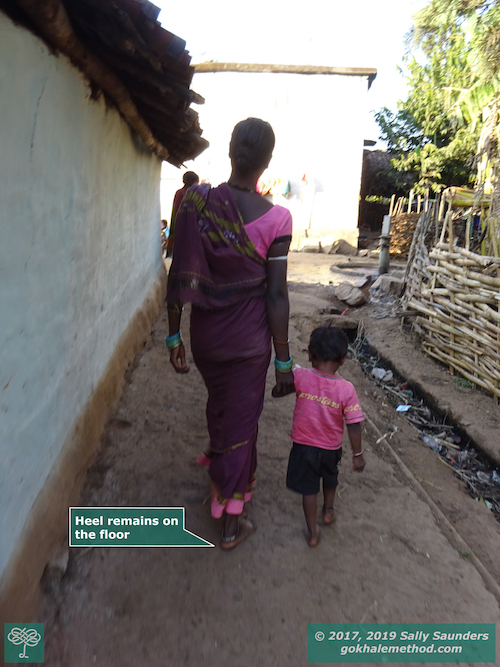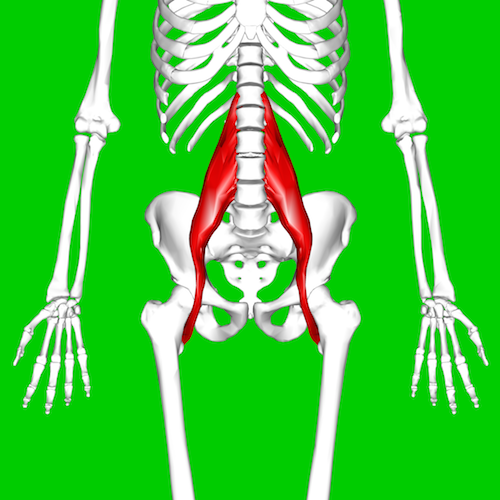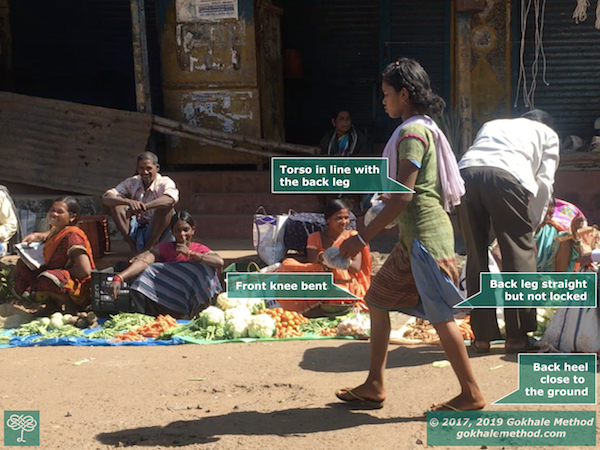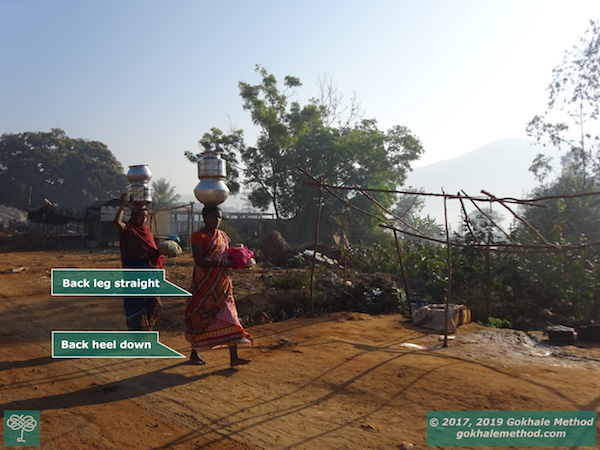Glidewalking: Sitting’s Long-Lost Counterpart

Mother and son in a tribal Orissan village demonstrating excellent walking form. Notice that their heels remain on the floor well into their stride.
Do you have tight psoas muscles? Do you suspect the cause is too much time spent sitting in your daily life? There’s a complementary activity that helps counterbalance the time we spend sitting: walking — or, more specifically, glidewalking. Glidewalking helps balance our sitting in numerous ways — walking is dynamic versus sitting which is static. Yang balances Yin, viewed in the framework of traditional Chinese medicine. One underappreciated way in which walking can balance sitting pertains to the psoas muscle.
The psoas muscle originates on the front of the sides of all the lumbar vertebrae and discs, and ends on the lesser trochanter of the femur.

This pathway is quite circuitous and runs adjacent to several pelvic organs. With long hours of sitting, the psoas can adapt to a short resting length. Original image courtesy Anatomography on Wikipedia under CC BY-SA 2.1 JP.
A short psoas pulls forward on the lumbar spine any time the legs are outstretched. This is why many people are uncomfortable lying on the back with outstretched legs, and why some people feel sciatic twinges when they stand and walk. The natural antidote for this tendency of the psoas muscle to shorten in sustained sitting is glidewalking. Glidewalking is really natural or primal walking given a special name because it is a rare thing in modern times and deserves to be celebrated with a special name! Every step done with proper form naturally stretches the psoas. That amounts to 5,000 mini psoas stretches on each side if you are glidewalking the recommended 10K steps a day. This will keep your psoas in a healthy, stretched out, pliable state!

This Orissan woman demonstrates beautiful walking form with her body in line with her back leg, her back leg straightened but not locked, and her back heel staying close the ground well into her stride.
The best way to get your psoas stretches, or resets, is to punctuate your day with glidewalking. No instance of glidewalking is insignificant: glidewalking to the bathroom, glidewalking to get a glass of water, and glidewalking in kinhin (walking meditation) all help. So are the longer, more obvious instances of glidewalking such as the daily constitutional and the weekend hike.

Orissan women carrying water on their heads. Notice how the woman in front propels herself off her rear heel. This additionally gives her a healthy psoas stretch with every step she takes.
It has become popular to consider that “sitting is the new smoking.” Poor form and long stretches of uninterrupted sitting do indeed have a deleterious effect on health, but I believe that a significant unknown contributor is that most people do not walk in a way that resets the psoas muscle after it shortens during extended sitting.
Apart from responding to extended sitting, the psoas muscle is also very responsive to psychological stress. We see this in the Moro reflex in babies when they respond to loud noises and traumatic stimuli such as real or perceived falling. Addressing psoas tension is at the core of certain body modalities, such as Tension & Trauma Releasing Exercises (TRE), and innovative developments in psychotherapy involving polyvagal theory.

This Rodin sculpture shows its subject well into a stride with the rear heel still down on the ground. This stance is a natural part of gait and stretches the psoas muscle.
It’s a tad complex to learn to stretch the psoas in glidewalking, but well worth the effort. It takes a combination of the following actions to do the job.
The rib cage needs to be anchored to stabilize the lumbar spine. Without this step, any other effort to stretch the psoas will result in arching the lower back.
The back heel needs to stay on the ground a long time into a stride. Most people lift their heel up from the ground prematurely, losing the full extent of the psoas stretch that nature designed to be built into every step.
The gluteal muscles of the rear leg engage appropriately, further augmenting the psoas stretch.
Proper technique can help you avoid the cycle of tight psoas muscles, reduced activity, tighter psoas muscles, further-reduced activity…
How much have you succeeded in putting these pieces together? What helped the techniques coalesce? The book? The DVD? One of our courses? A topical workshop on glidewalking for our Gokhale Method Alumni? I’d love to hear from you in the comment section below.

Comments
Wondering about the psoas and
Wondering about the psoas and tension from trauma due to surgeries, in particular the large amount of women having c-sections and repeat c-sections. I have had multiple issues after a hernia repair as a baby and then a c-section with my first child. This maybe is an issue to explore with problems with posture, trauma, tight psoas muscles, scar tissue and adhesions in the pelvic area. For some, such as myself, it has caused a body-wide myo-fascial pain syndrome, especially in the lower back, hips and pelvic area.
Wondering if Esther has any reserach on this? I have had my c-section scar manually worked on, and this did help. Recently had the pubic bone attachments manually manipulated to help free up this area and it set off a firestorm of paina and tenderness (not a normal reaction) in the whole area that the psoas travels through. It got me to thinking that there is a relationship.
Thank you for all you do,
Mary Owens
No research in this area -
No research in this area - just educated guesses. I like to think of healthy movement as a kind of massage. To be safe I recommend "small" movement for short duration, to be expanded later. Hope you unravel what's going on.
I couldn't understand this
I couldn't understand this from the book, but this post was very helpful.
So glad!
So glad!
I have read the book and have
I have read the book and have tried implementing as much as possible. My back pain has even disappeared. But the back of my calves have always been very tight. As a toddler and child, I even walked exclusively on the balls of my feet, heels never touching the ground. So I am still struggling to understand glidewalking.
Add New Comment
Login to add commment
Login